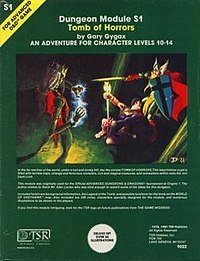In my A Game Per Year project, my goal has been to read one roleplaying game corebook for every year they’ve been published. However, I soon started to feel that it was hard to decipher how the games were really meant to be played. For this reason, I decided to start a parallel project, An Adventure Per Year, to read one roleplaying adventure for each year they’ve been published.

At first, D&D publisher TSR didn’t get into adventure publication because they believed that GMs would like to create their own adventures. However, demand and the efforts of third party publishers soon demonstrated that there was demand for adventures and TSR entered the field as well.
Tomb of Horrors is a legendary roleplaying adventure famous for being incredibly deadly. Indeed, it’s an example of GM vs. players -style design, created to force players to play with maximum paranoia. In this adventure, you really do need the ten foot pole.
The adventure was originally created by D&D co-creator Gary Gygax for tournament play in 1975, intentionally designed to challenge experienced players.
The titular tomb of the adventure is the resting place of a demilich called Acererak. One of my favorite things about the adventure is the way it starts. The characters find the hill under which the tomb is built but there’s no entrance. To get inside, they’ll need to start digging. To me, this feels like a clear statement of intent about what kind of a dungeon adventure this is going to be.
Another interesting thing about the tomb is that’s it’s almost totally trap-based, with nary a monster in sight. It’s a puzzle the players have to solve, and demonstrates why D&D has so many spells in the Passwall and Move Earth category. Indeed, it feels like the ideal party for the adventure would consist entirely of wizards.
Tomb of Horrors is the first proper, seriously designed roleplaying adventure I’ve read during this project. It’s traps are extremely deadly and unfair but its a result of thoughtful, intentional and careful design. The contrast to the adventures Palace of the Vampire Queen and Tegel Manor is significant. Tomb of Horrors also engages with D&D’s system on a much deeper level, as a capacity to use spells effectively and cleverly is essential to beating it.